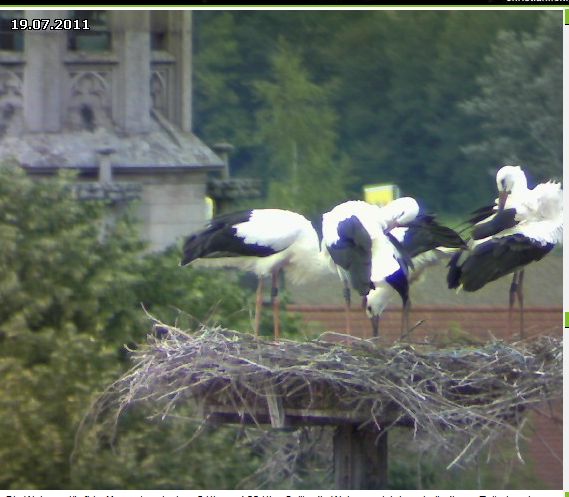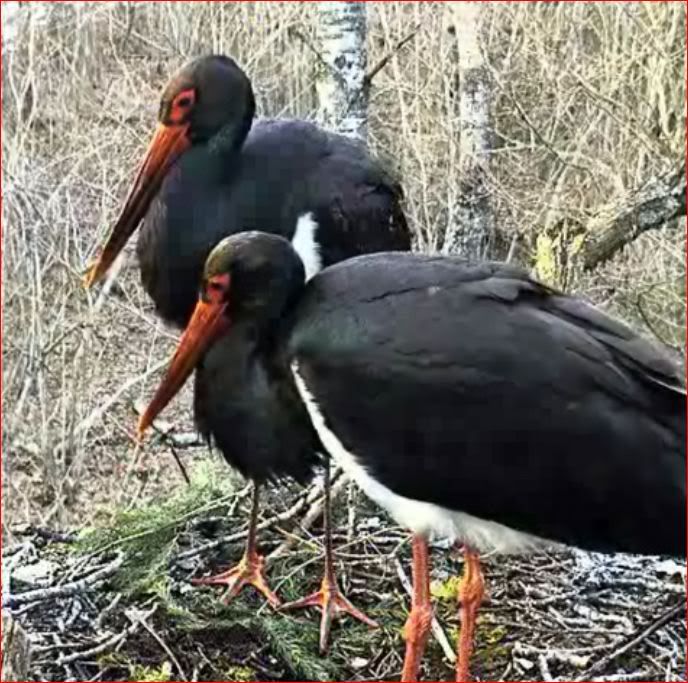Page 17 of 23
Re: Pictures and Information about Storks
Posted: June 9th, 2011, 2:15 pm
by Olga
Mutikluti!

Amazing, the photos of the real reality, of a White Stork are stunning.

Re: Pictures and Information about Storks
Posted: July 15th, 2011, 12:49 pm
by macko50
Black Storks nest Belgium
New videos
There are a lot of nice new videos about the nest on vimeo.
http://www.solon.be/category/la-cigogne-noire/
Re: Pictures and Information about Storks
Posted: July 19th, 2011, 7:26 pm
by Brit
Hammelburg today:

Re: Pictures and Information about Storks
Posted: July 20th, 2011, 6:47 am
by alice44
I just stumbled upon this amazing image of a black stork catching a fish
http://1x.com/photo/41925/album/25840
Re: Pictures and Information about Storks
Posted: September 10th, 2011, 10:19 pm
by Katinka
Epilog on 2011 Suivi Webcam - BS nest in Belgium
After the breeding sessions having ended all around, here's a final summary for the Belgian web site
http://www.solon.be/category/la-cigogne-noire
(translation kindly done by
macdoum):
A breakdown of the electric link did not allow us to finish the nesting season as we wished.
Offside camera everything went perfectly well. The 4 young BS flew away during the last 15 days of July.
The nesting season in (whole Belgium) Wallony went perfectly well. Most of the young BS were ringed.
Storklets from 2 nests were extremely late (hatching), a phenomenon we have never seen before.
Each of the nest had one storklet and fledging were very late, so they will leave the nests not before the first week of September.
Something unheard of leaving so late for the migration.
If interested, the page started
video reports on 2010 with
http://www.solon.be/category/la-cigogne-noire/page/21.
If you'd like to follow it chronologically, only click on
Newer at the page's bottom.
Re: Pictures and Information about Storks
Posted: October 2nd, 2011, 9:39 pm
by Katinka
 Here
Here  - first video in the row of “Sachinfos” – to maximize the window, use the icon from image bar
- first video in the row of “Sachinfos” – to maximize the window, use the icon from image bar
(And please don’t mind of the low quality – it’s due to the capacities within a governmental institution!)
is Carsten’s 2011
ringing performance of the BS, no similar German video documents available. In 2010 he first visited the nest, which is situated in a forest in the middle of Germany, on a 25 m-high beech tree. The breeding site is known since 2008 – one parent is wearing a ring from France, dated 2005.
My translation of comments and interview into English:
- Middle of June…suddenly a stranger…he dares to come so close…
Today is a very special day: the little BS are to be ringed – and that doesn’t please them at all.
C. R.: “Ringers are always very surprised to find “aggressive” storks when climbing up. But BS behaviour is different to the white storks’ – no akinesis. In opposite to it BS have to defend their selves against an enemy (e. g. raccoon or marten).
Because the siblings are mainly alone in the nest [from 3 rd week on], they’ve to be aggressive! Hacking in direction to my eyes or loud muttering hall cause fear on fictive enemies.”
To calm the 4 down, Carsten has put over them a light blanket. Being on their 35 th living day, they’ve reached the best ringing age: on one hand big enough, on the other not too much mobile that they could fall out due to all the excitement.
Now each young one is getting its own personal sign.
C. R. shows the 2 rings: “This year the common ring is fixed at the right side [changes are done yearly], with the dates of Vogelwarte Radolfzell [Southern Germany] – the so called ELSA-rings [black] which are also taken for the WS. The two other birding stations Helgoland (N. Sea) and Hiddensee (Baltic S.) still use metal rings.
At the other leg (above intertarsal wrist) it’s getting the ID ring [here: T128 - T131] Coloured rings are used in Germany since 6 years [within the European BS ringing project]. The German code is the “T” [hist. for “Teutonia”; the “Teutonen” or as in English is said the “Huns” were a famous ruling tribe]. Afterwards the “T” come ongoing numbers (other nations can have number-letter combinations like Czech [image: green rings] – all large enough to be read during observations.”
The reading is important to get as much information as possible about the BS’ live, like “Does the BS continue to use its breeding site?” or “What tracking route is it preferring?”
The systematic BS ringing in Germany wasn’t done until 2005. C. R. is one of 2 ringers here [not correct – he names more on his web page] and is it with heart & soul. That he’s doing the seasons as a volunteer shows much. Perhaps there’ll be some meeting with his ringed ones at their wintering site.
“I hope to meet eventually one during my stay in Israel this autumn – which is rather impossible, as our German BS are “Western trackers”. But there are always exceptions, and single are observed to take the Eastern track.”
In the nest everything has calmed down again, and the Four can continue their growing-up.
In August they’ll be looking forward to a great journey.
P.S. On
http://blackstorknotes.blogspot.com/sea ... ck%20Stork, you can read that he’d been on his ringing tour for about 6 weeks, as a volunteer with a small job behind.
He’s ringed in total in 52 nests 187 young BS personally, in 6 further nests were 21 young ones.
…And he mentions the number of
failed eggs with 17 in 15 nests. Reasons for this serious observation during the last years are discussed with Latvian expert
Maris Strazds…
Source: http://schwarzstorchberingung.de/page16.php
Re: Pictures and Information about Storks
Posted: November 4th, 2011, 1:04 pm
by Felis silvestris
I am posting this link here as well, just posted it in the LSE forum, but on this site there are such great BS photos as well, so enjoy!
http://www.krumenacker.de/en/lesser_spo ... _Migration
Re: Pictures and Information about Storks
Posted: November 11th, 2011, 9:54 pm
by Katinka
For those who are still addicted to the BS topic at this time of the year...
I recently found a video from
Latvia, dealing with the BS population in the Baltic states in common.
Here you learn to know the famous "old" Lord of the black storks, Māris Strazds - who actually is not older than 51 - what a beard can do to one's charisma...
As I mentioned here 2 posts before, Māris has a name - everyone who is dealing with BS conservation is referring to him and his silent
(to us amateurs) observation and researches in Latvia and other BS countries.
But take your time and watch for 5 min what he has to say - while ringing some young ones on the ground, this year.
(For non-native English speakers, better watch twice - for the treatment of the BS could be too fascinating to listen to his important report at the same time)
It is a
Vimeo-based video.
Re: Pictures and Information about Storks
Posted: November 12th, 2011, 8:23 pm
by Jo UK
Thank you, Katinka.
That is a very important film.
So chilling, that the last word spoken on that film was "extinction"
Re: Pictures and Information about Storks
Posted: November 13th, 2011, 12:28 am
by macdoum
Jo UK wrote:Thank you, Katinka.
That is a very important film.
So chilling, that the last word spoken on that film was "extinction"
Its very sad and depressing..

Re: Pictures and Information about Storks
Posted: December 16th, 2011, 9:44 pm
by asteria
Re: Pictures and Information about Storks
Posted: December 16th, 2011, 11:43 pm
by macdoum
Lovely photgraphs Asteria.

Re: Pictures and Information about Storks
Posted: December 17th, 2011, 9:11 am
by alice44
macdoum wrote:
Lovely photgraphs Asteria.

For me it was especially nice to see the first photo with the heron -- since I know Great Blue Herons, which are pretty similar to Grey Herons, it gave me a much better sense of the Black Storks.
Re: Pictures and Information about Storks
Posted: December 17th, 2011, 2:21 pm
by asteria
It is interesting that all those birds are staying there together and don't chase each other away.
Re: Pictures and Information about Storks
Posted: March 31st, 2012, 10:52 am
by unp
A recent doctoral thesis on
Breeding and migration of the Black Stork says "the knowledge about the migration routes of European Black Storks needs to be reviewed" (pp. 79 and 80) and draws more new conclusions (pp. 87 and 88).
http://ganymedes.lib.unideb.hu:8080/dea ... eges-t.pdf
Re: Pictures and Information about Storks
Posted: April 12th, 2012, 2:10 pm
by Jo UK
I snipped and enlarged an image posted by Olga. It shows clear differences between Tiit (rear) and Tiina.
The red area round the eyes is a different pattern, and the two beaks are different in shape, size and colour.
Thanks, Olga, for a clear picture.


Re: Pictures and Information about Storks
Posted: April 22nd, 2012, 9:19 pm
by macko50
BS nest in Belgium 2012
They have started a new video series from a new nest a week ago.
As I see they upload videos regularly.
http://vimeo.com/40362898
Re: Pictures and Information about Storks
Posted: July 2nd, 2012, 12:17 am
by AquHeli
Greetings From Hungary

Re: Pictures and Information about Storks
Posted: July 2nd, 2012, 12:37 am
by Jo UK
Welcome to the forum, AquHeli.
What a gorgeous picture!

Re: Pictures and Information about Storks
Posted: July 2nd, 2012, 2:31 am
by AquHeli
thanks
I bring some pictures!

 Amazing, the photos of the real reality, of a White Stork are stunning.
Amazing, the photos of the real reality, of a White Stork are stunning. 



